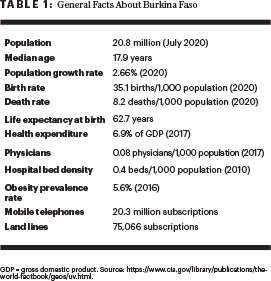The ASCO Post is pleased to continue this occasional special focus on the worldwide cancer burden. In this issue, we feature a close look at the cancer incidence and mortality rates in Burkina Faso. The aim of this special feature is to highlight the global cancer burden for various countries of the world. For the convenience of the reader, each installment will focus on one country from one of the six regions of the world as defined by the World Health Organization (ie, Africa, the Americas, Southeast Asia, Europe, Eastern Mediterranean, and Western Pacific). Each section will focus on the general aspects of the country followed by the current and predicted rates of incidence and cancer-related mortality. It is hoped that through these issues, we can increase awareness and shift public policy and funds toward proactively addressing this lethal disease on the global stage.

Hope Craig, MSPH

Chandrakanth Are, MBBS, MBA, FRCS, FACS
Burkina Faso is a landlocked country located in the heart of West Africa, bordered by Mali, Niger, Benin, Togo, Ghana, and the Ivory Coast. With a population of more than 20 million (Table 1) and over 60 ethnolinguistic groups, Burkina Faso is home to an ethnically and culturally diverse population known as the Burkinabe. Though French is the official language of government and business due to a history of French colonization, the majority of the population of Burkina Faso speaks the native language of Moore.
Burkina Faso is categorized by the World Bank as having a low-income economy. In 2017, the estimated gross domestic product (GDP) was $35.9 billion with a growth rate of 6.4%, up from 5.9% in 2016. However, around 40% of the population continues to live below the poverty line, and about 80% of the population relies on subsistence farming and agriculture as a primary livelihood.1 Due to challenges related to unsustainable income, the socioeconomic condition of the majority of the population remains unstable.
Health-Care in Burkina Faso
Though the health-care workforce increased between 2006 and 2010, it was not enough to meet the population’s growing needs. In 2017, the physician density was one physician per 100,000 people, and hospital bed density was four beds per 10,000 people. (In the United States, the physician density is 278 physicians per 100,000 people; the hospital bed density is approximately 20 beds per 10,000 people.)

Recent achievements in the health-care workforce include the creation of the 2010 Human Resources for Health plan and a census of all public sector human resources for health-care delivery and infrastructure. More recently, with the assistance of the Global Health Workforce Alliance, led by the World Health Organization, Burkina Faso has engaged stakeholders across the country in the process of implementing, monitoring, and evaluating an updated Human Resources for Health plan to address continued challenges related to the recruitment and training of health workers.2
Burden of Cancer
The burden of cancer in Burkina Faso continues to grow every year. As of 2020, breast cancer, liver cancer, and cervical cancer are the top three cancers by incidence and mortality (Figures 1 and 2).3 Although cancer incidence and mortality rates in Burkina Faso are comparable to those in sub--Saharan Africa and Western Africa, cervical cancer incidence in Burkina Faso is more than two times higher than that of high-income countries, and the mortality rate is more than five times higher. Efforts are being made to deal with the rising rates of cancer incidence by government members and researchers.4
“With the increase in both new cancer cases and deaths (Figures 3 and 4), this disease has become a public health priority for Burkina Faso,” said Léonie Claudine Lougue, the country’s Minister of Health. “The way we tackle cancer and cancer control planning needs to be strengthened. Upgrading health professionals’ skills is essential in responding to these challenges, particularly as we are planning to expand radiotherapy services.”5
Cancer management needs are high, including health-care provider training, demand generation and utilization of prevention and treatment services, as well as patient monitoring. Early detection and vaccination present promising opportunities to reduce high disease burden, particularly for cervical cancer, in the Burkinabe context. For some time, underutilization of screening services was a key barrier such that, in the mid-2000s, screening activities in Burkina Faso covered only between 5% and 8% of the target population.5

Since then, the Ministry of Health, professional associations, and organizations have initiated cervical cancer screening campaigns using visual inspection with diluted acetic acid, which has improved access to low-cost screening services.6 Treatment of precancerous lesions, including cryotherapy, has remained unavailable, however, leaving 1.7 million women between the ages of 30 and 59 without access to secondary prevention of cervical cancer.7 The single-visit approach—screening with same-day cryotherapy—offers promise, as it requires minimal infrastructure and can be practiced by trained nonphysician health-care providers.8
Furthermore, at the 2019 International Atomic Energy Agency Scientific Forum on cancer care, Sika Bella Kaboré, First Lady of Burkina Faso, joined as a speaker, highlighting a strong political will for advances in cancer prevention and treatment:
The burden of cancer for women is high in Burkina Faso. Patients face stigma, late diagnosis, and limited access to medicines, especially in rural areas…. Access to radiotherapy, increased specialist staff training, and greater public awareness are crucial in order to respond to their needs and save them from traveling abroad for treatment. Today, more actors are actively involved, and there is a strong political will in the fight against cancer.5
Opportunities to advance policy and planning for cancer prevention and treatment are underway. In 2019, the Ministry of Health requested an imPACT review—an integrated mission of the Programme of Action Cancer Therapy—to examine the country’s readiness to provide cancer services. The imPACT report identifies priorities and actions to increase availability and public access to cancer services and is set to inform the development of a National Cancer Control Plan for 2020 to 2024.9
DISCLOSURE: Ms. Craig reported no conflicts of interest. Dr. Are is a board member with Global Laparoscopy Solutions Inc; has received research funding from Pfizer; and has a patent with the University of Nebraska Medical Center for a laparoscopy instrument.
REFERENCES
1. Central Intelligence Agency: The World Factbook—Africa: Burkina Faso. Available at https://www.cia.gov/library/publications/the-world-factbook/geos/uv.html. Accessed December 23, 2020.
2. World Health Organization, Global Health Workforce Alliance: Burkina Faso. Available at https://www.who.int/workforcealliance/countries/bfa/en/#:~:text=Burkina Faso suffers from a,Health%2C Statistical Yearbook 2010. Accessed December 23, 2020.
3. International Agency for Research on Cancer, World Health Organization: Cancer Today/Population Fact Sheets: Burkina Faso, Globocan 2020. Available at http://globocan.iarc.fr/Pages/fact_sheets_ population.aspx. Accessed December 24, 2020.
4. Louie KS, De Sanjose S, Mayaud P: Epidemiology and prevention of human papillomavirus and cervical cancer in sub-Saharan Africa: A comprehensive review. Trop Med Int Health 14:1287-1302, 2009.
5. International Atomic Energy Agency: Hitting 100: IAEA Cancer Control Review Marks Milestone in imPACT Delivery. September 13, 2019. Available at https://www.iaea.org/newscenter/news. Accessed December 24, 2020.
6. Ouedraogo Y, Furlane G, Fruhauf T, et al: Expanding the single-visit approach for cervical cancer prevention: Successes and lessons from Burkina Faso. Glob Health Sci Pract 6:288-297, 2018.
7. Compaore S, Ouedraogo CMR, Koanda S, et al: Barriers to cervical cancer ccreening in Burkina Faso: Needs for patient and professional education. J Cancer Educ 31:760-766, 2016.
8. Blumenthal PD, Lauterbach M, Sellors JW, et al: Training for cervical cancer prevention programs in low-resource settings: Focus on visual inspection with acetic acid and cryotherapy. Int J Gynecol Obstet 89(suppl 2):30-37, 2005.
9. International Atomic Energy Agency: Burkina Faso. Technical Cooperation Programme, July 2020. Available at https://www.iaea.org/sites/default/files/20/07/tc-burkina-faso.pdf. Accessed December 24, 2020.

